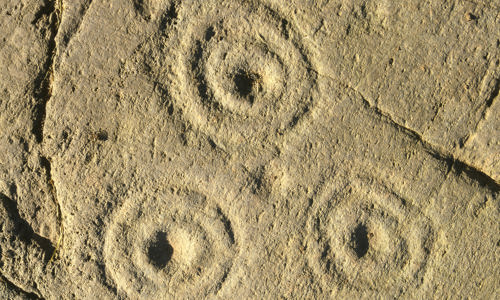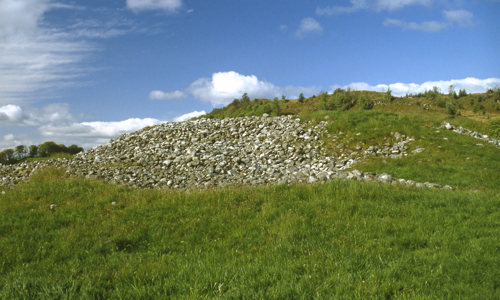History
A cairn apart
Kilmartin Glen is known for its linear cemetery of five prehistoric burial cairns. They form a 2km-long line across the valley floor, from Glebe Cairn in the north to Ri Cruin in the south.
Dunchraigaig Cairn is of the same form and date, but it doesn’t fall into line. It sits a little to the south-east of the other cairns.
Unusual finds
Like the other Kilmartin cairns, Dunchraigaig is about 30m wide. But excavations in the 1800s showed it was quite an unusual monument.
The cairn has three cists inside. The cist to the east contained only cremated bones. The central cist contained a full-length body on top of its cover slab, with cremated human bones inside and below this a layer of rough paving which revealed yet another body, in a crouched position.
But the third cist, on the south-east side was the most unusual. Dug directly into the ground, lined with drystone cobbled walls and capped with a massive stone, it contained the remains of up to 10 individuals, some cremated and some not. It also held a whetstone, a greenstone axe and a flint knife.
While cairns often became the burial place of more than one individual, it is rare to find so many individuals in one cist. Bronze Age cist burials, like this one, were usually reserved for one person – multiple burials are more often seen in Neolithic tombs.
A prehistoric landscape
A rich prehistoric landscape survives in Kilmartin Glen, providing a tantalising insight into its prehistoric population. The surviving rock art along the glen is remarkable for the number of elaborately carved outcrops, the style of and extent of the carvings, and their close association with other prehistoric monuments. No other place in Scotland has such a concentration of prehistoric carved stone surfaces, and Neolithic and Bronze Age monuments.
Other carved rock outcrops around Kilmartin Glen include:
Other monuments include:
- Dunadd Hill Fort
- Glebe Cairn
- Nether Largie North Cairn
- Nether Largie Mid Cairn
- Nether Largie South Cairn
- Ri-Cruin Cairn
- Temple Wood Stone Circle
The glen is also home to an important collection of medieval sculptured stones.










